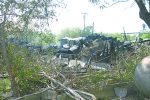Oil spill reaches Texas beaches
By LPR Staff
Editor/POST-REGISTER
Whether it was carried by Gulf currents or hitched a ride on one of the boats helping to clean up the massive oil spill in the Gulf of Mexico, the evidence of Deepwater Horizon-related oil has been found on Texas beaches.
On Saturday, crews spotted and later removed nearly five gallons of tarballs from the beaches on G
alveston Island and the Bolivar Peninsula. Chemical testing later confirmed the tarballs to have come from the well ruptured when the Deepwater Horizon drilling platform exploded on April 21. The site has been spewing oil at rates estimated between 35,000 and 60,000 barrels per day into the Gulf waters. Most of the oil has drifted north and east, polluting the shorelines of Louisiana, Mississippi, Alabama and Florida, but officials knew it was only a matter of time before the sludge reached the Lone Star State.
“We’ve said since day one that if and when we had an impact from Deepwater Horizon, it would be in the form of tarballs,” said Texas Land Commissioner Jerry Patterson on Monday. “This shows that our modeling was accurate. Any Texas shores impacted by the Deepwater spill will be cleaned up quickly and BP will be picking up the tab.”
Although officials confirmed the tarballs were a product of the Deepwater Horizon spill, it was unclear on Wednesday morning how they got to the Texas shoreline. Because of their chemical make up and the fact the oil was “lightly weathered,” Coast Guard officials suggested the tarballs were carried by ships which assisted with cleanup efforts and later ported in Galveston, rather than drifting naturally on the Gulf currents.
Weathering processes generally create tarballs that are crusty on the outside, and softer and “gooey” on the inside, a release from Patterson’s office said. The tarballs collected in the Galveston area were largely “gooey,” suggesting they had not experienced the amount of weathering that would have occurred had they drifted naturally.
Because of their size and makeup, tarballs cannot be prevented from reaching the shore with boons. They do not float on the water’s surface, and usually only be cleaned up after they make landfall.
Although tarballs can be the size of pancakes, most are coin-sized.
In small amounts, they are not dangerous for people to come in contact with, Patterson said, although obviously accidental ingestion could be toxic.
“For most people, a brief contact with a small amount of oil will do no harm,” he said. “If contact occurs, wash the area with soap and water, baby oil [or another safe cleaning compound].”
On Tuesday afternoon, Attorney General Greg Abbott announced he had spoken with BP’s general counsel and requested $25 million be allocated to fund Texas’ response and clean up efforts. So far, each of the other Gulf States has received a similar allocation.
He also requested that claims offices be opened in Texas so that coast residents, businesses and fishermen can seek compensation for economic harm they suffer as a result of the spill.
“My request was submitted to [general counsel Kenneth R. Feinberg] earlier today,” Abbott said. “Based upon [his] very helpful comments during our conversation, I am confident that claims offices will be opened in the State of Texas in the next few weeks.”
In general, the National Oceanic and Aquatic Administration (NOAA) suggests the impact to Texas’ most popular tourist beaches will be minimal, at least in the foreseeable future. The most recent models reflect an expectation of oil coming ashore only in the northern and easternmost portions of the Texas shoreline, a possibility which is projected as still being months away.
However, the City of Galveston, the Texas General Land Office and the Coast Guard are stepping up patrols to scan the beaches for tarballs, and expanding helicopter patrols to look for sources of oil sheen resulting from the spill.
Regardless, Patterson said, “Texas beaches are open.”



